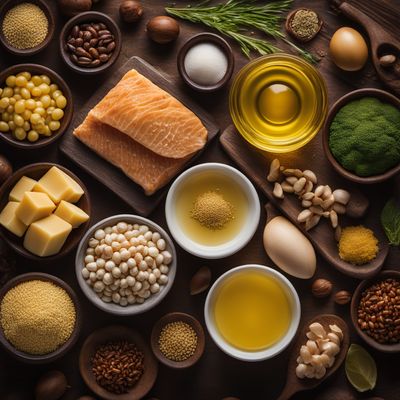
Ingredient
Animal fats and oils (processed fat from animal tissue)
The Essence of Animal Fats and Oils
Animal fats and oils are derived from the tissues of animals and can vary in color, texture, and flavor. They can be solid or liquid at room temperature, with a range of melting points. These fats are prized for their ability to impart a distinct richness and savory taste to dishes, while also providing moisture and enhancing texture. Whether it's the creamy smoothness of butter or the smoky depth of bacon fat, animal fats and oils are essential ingredients in many cuisines around the world.
Origins and history
Animal fats and oils have a long history of use in cooking and food preservation. Rendered animal fats, such as lard and tallow, have been utilized for centuries in various cultures. They were commonly used before the advent of vegetable oils and continue to be valued for their unique flavor and cooking properties. Animal fats have played a significant role in traditional dishes, such as French cuisine's use of duck fat in confit or Mexican cuisine's reliance on lard for making tortillas. Their cultural significance and historical relevance make them an integral part of culinary heritage.
Nutritional information
Animal fats and oils are a concentrated source of calories, providing 9 calories per gram. They contain varying amounts of saturated and unsaturated fats, with some types being higher in cholesterol. While they can add flavor and texture to dishes, it is important to consume them in moderation as part of a balanced diet.
Allergens
May contain allergens such as milk proteins (in butter) or traces of proteins from other animal sources. Individuals with specific allergies or dietary restrictions should exercise caution and read labels carefully.
How to select
When selecting animal fats and oils, look for products that are fresh and free from any off-putting odors or flavors. Opt for those that are minimally processed and have a clean, pure appearance. For butter, choose unsalted varieties to have more control over the salt content in your recipes. When purchasing rendered fats like lard or tallow, consider the source and opt for high-quality products from reputable suppliers.
Storage recommendations
To maintain the freshness and quality of animal fats and oils, store them in airtight containers in a cool, dark place, away from direct sunlight or heat sources. Butter should be kept refrigerated, while rendered fats like lard or tallow can be stored at room temperature. It is important to check the expiration dates and discard any fats that have gone rancid or developed an off smell or taste.
How to produce
Animal fats and oils can be produced by rendering the fat from animal tissues. This can be done at home by slowly heating the fat over low heat until it melts and separates from any solids. The liquid fat can then be strained and stored for future use. However, it is important to note that rendering animal fats can be a time-consuming process and requires caution to prevent burns or accidents.
Preparation tips
Animal fats and oils can be used in a variety of cooking techniques, including frying, sautéing, and baking. Butter adds richness and flavor to baked goods, while bacon fat imparts a smoky depth to savory dishes. Lard is prized for its ability to create flaky pie crusts and crispy fried foods. Experiment with different fats to discover their unique characteristics and how they can elevate your culinary creations.
Culinary uses
Animal fats and oils are widely used in culinary applications around the world. They are essential ingredients in dishes such as pastries, sauces, gravies, and stews. In French cuisine, butter is a key component in sauces like beurre blanc, while lard is used in traditional Mexican dishes like tamales and refried beans. Animal fats and oils also play a significant role in Southern American cooking, where they are used for frying chicken and making biscuits.
Availability
Animal fats and oils are commonly available in grocery stores and supermarkets worldwide. However, the specific types and varieties may vary depending on the region and cultural preferences. Local butchers or specialty stores may offer a wider selection of rendered fats or specialty animal oils.

